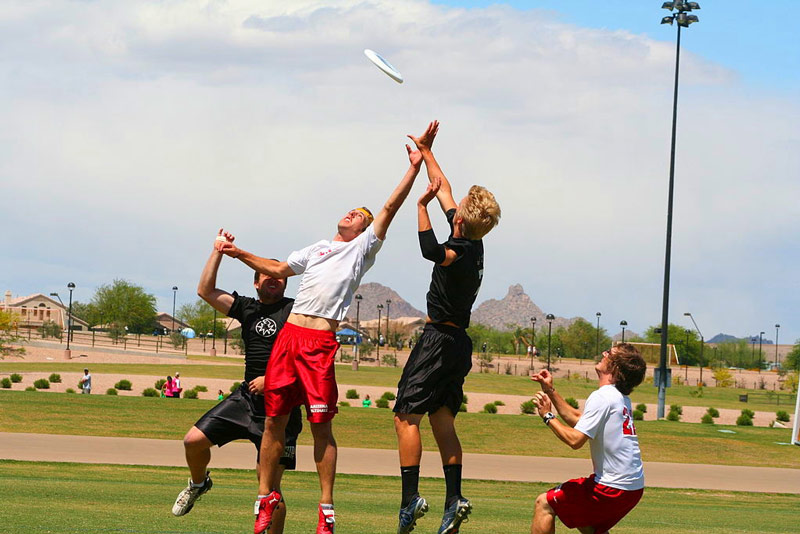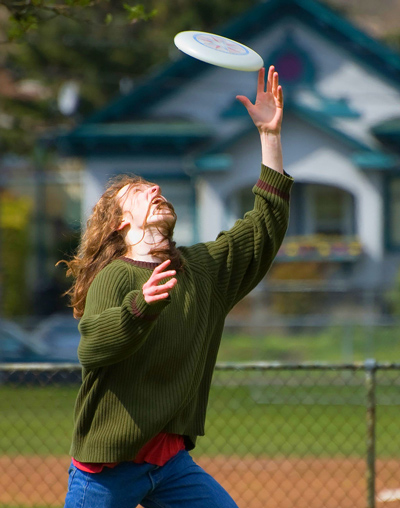How To Catch A Frisbee – Master The Ultimate Frisbee Catches
To become a good and proficient player, you need to learn the Ultimate Frisbee catches. The goal is to catch it in the right manner no matter the speed. Unfortunately, many-a-player take catching for granted. Yes, they will spend lots of time throwing the disc and perfecting their accuracy. However, a majority will spend little or no time to improve their catching. Their lack of skill will show in the field and they will more-often-than-not drop or miss the Frisbee, let their team down and probably lose. Generally, the catches can be grouped as follows.

Most Commonly Used Ultimate Frisbee Catches
1. The One-Handed Catch
 This is among the challenging catches in Ultimate Frisbee but it may be the only option you have in the field. Imagine trying to catch a disc that is flying too close to the ground or fighting for a high-thrown Frisbee? Naturally, you will be able to jump much higher with one hand up, compared with reaching with both arms in the air. The secret to making a good catch is always timing the disc and having the thumb and index finger wide open. You immediately close the two fingers the moment the disc hits the space in-between. Too small a gap and chances are it will land beneath or above the hand.
This is among the challenging catches in Ultimate Frisbee but it may be the only option you have in the field. Imagine trying to catch a disc that is flying too close to the ground or fighting for a high-thrown Frisbee? Naturally, you will be able to jump much higher with one hand up, compared with reaching with both arms in the air. The secret to making a good catch is always timing the disc and having the thumb and index finger wide open. You immediately close the two fingers the moment the disc hits the space in-between. Too small a gap and chances are it will land beneath or above the hand.
Pro TIP: when the disc is flying below the elbow or waist level, try catching the Frisbee with thumb facing up. However, if it is above the head, then the thumb should be facing down. Practicing the catch as part of the Ultimate Frisbee drills helps to perfect the skill and learning the best approach.
Pro TIP: in order to improve your chances of catching the disc you should use a set of special Ultimate Frisbee gloves, also known as friction gloves. They provide great grip and drastically improve the chances of catching a flying Frisbee. Check out our list of the best ultimate Frisbee gloves out there.
2. The Two-Handed Catch
The two-handed catch is much easier and simpler than the one-hand catch. In fact, it is the most commonly used. It gives you more room for catching. A player uses both hands and will snap them together on the flying disc.

This style is appropriate for discs that are flying a few inches below the knees going upwards. However, it may not be very practical if the disc is way above the head or when you are jumping. It is also suitable for catching a disc from a side angle. The two-handed catch is further divided into the following categories:
– Pancake Catch: It is suitable for discs that are moving towards you. All you do is simply close the two palms together to grasp the disc. The palms will be facing each other at right angles to the disc and will be very close to the body. The technique works on a disc from waistline to slightly above the head and is perfect for catching a slow flying disc. It is critical to get the trajectory right as you may clap the two hands either too early or too late meaning it either hits the front of your closed palms or your body after passing through the open hands. In either case, the disc will drop to the ground.
– Crocodile Catch: this style is almost similar to the pancake technique only that the arms will be fully stretched out in front of you. The body and the arms will be oriented in the same direction of the disc and you need to keep them parallel. It’s very effective for catching fast flying discs since it provides a larger space and you will be moving parallel to the disc. Just like in the pancake technique, you should correctly anticipate the trajectory.
– Rim Catch: This is one of the difficult techniques to master and apply and will usually be used by pros. You will use it in situations, which could have also been suitable for a one-handed catch, but where you actually need a bit more grip. For instance, a disc that is too close to the ground or at the ankle level. Using two hands here would ensure that you don’t miss it. It simply gives you more control than one hand. You can also use this catch for a disc flying way above your head, but in reach for a two-handed grab.
It works like this: the player grabs the disc while placing both hands on the leading edge. Due to the slightly difficult position, there is always a likelihood of the disc spinning out of control because of hitting it with one hand before the other can offer extra support. This is why players aren’t encouraged to use this technique unless it is necessary and unless they have a lot of practice.
Summing Up
Catching the Frisbee is equally as important as throwing it. And now you know more about how to catch a Frisbee and what are the main ultimate Frisbee catches. But that is not enough. We always advise all of you to put lots of emphasis on the technique, in order to become better players. This means regularly performing drills that purely focus on the catching. For instance, get together with your friends and toss the disc at one another at varied speeds, heights, and angles, over and over again. Try one-handed catches, two-handed catches, or dive for difficult catches. In time, you will get better, guaranteed. The more you practice, the better your catching skills become.
Speaking of practice, if you want to become a better catcher, you should check out our drills to help you become THE ultimate Ultimate-player. 🙂
Also, keep in mind that being well equipped will improve your performance during the game. A set of good ultimate gloves will greatly improve your grip and odds of not dropping the Frisbee, while a good pair of cleats will boost your traction on the field and give you the extra edge you need when you run to make a hard catch. You should check out our selection of the best ultimate cleats for that, too.
Now go win some games!
Last but not least, also keep in mind that apropriate equipment might also increase your chance to win. So gear up apropriatelly. You can for instance check which are the best cleats for ultimate frisbee, since these will drastically improve your traction. Or what kind of ultimate apparel is best for you.